Have you ever wondered why some apps are free while others require payment? It’s a puzzling question that dances in the minds of app creators everywhere. Well, millions of apps on app stores might give users the same service, but some are paid apps, and some are free apps.
So, why do creators lean towards making their apps free? Simple, because you do, too! Picture this: you’re given a choice between a paid app and a free one, both offering the same thing. Which one grabs your attention first? You guessed it, the freebie! Why? Because no one wants to gamble their money on something they’re not sure about.
But hold on, does that mean people never pay for apps? Not quite! We’re not opposed to spending, but we want to know what we’re getting into first. Now, if you’re thinking, “Okay, I get it, but how can I make money from a free app?”
Get ready because we’re about to explore how free apps can make money. First, let’s shortly see the journey of paid and free apps.
Paid vs. Free apps
Paid Apps
Paid apps, characterized by an upfront purchase cost, entice users with the promise of premium features. This model ensures immediate revenue, but it can limit the app’s reach because, as mentioned above, users might hesitate to invest in an app without understanding its utility and functionality first.
Free Apps
Free apps, on the other hand, adopt a ‘freemium’ approach, allowing users to download and access basic features without any initial charge. This model casts a wider net, instantly engaging a broad user base. These apps rely on alternative revenue streams, leveraging creative methods to sustain their operations and foster continuous development.
Most effective ways to make money from a free app:
- In-app advertising
- Affiliate marketing
- Freemium apps
- In-app purchases
- Sponsorship
1. In-App Advertising
In-app advertising stands out as one of the most prevalent revenue generation methods in the realm of free apps. Developers strategically place ads within the app’s interface, offering users the opportunity to engage with various ad formats seamlessly. These formats include quiet banner ads at the top or bottom of the screen, full-screen interstitial ads appearing during natural breaks, and rewarded videos that grant users in-app benefits upon completion.
Types of In-App Advertising:
- Banner Ads: These unassuming ads are displayed persistently on the app interface, ensuring constant visibility without disrupting user experience significantly.
- Interstitial Ads: Full-screen ads, strategically timed, provide engaging visuals without interrupting the app’s flow, often appearing between levels or during transitions.
- Rewarded Videos: Users willingly view short video ads in exchange for in-app rewards, enhancing user engagement and providing value to both parties.
How In-App ads work?
Advertisers pay for the app based on the number of ad impressions, clicks, or specific user interactions. This model ensures a steady revenue stream for the app, enabling developers to continue offering their services for free.
2. Affiliate Marketing
Affiliate marketing emerges as another great avenue for free apps to generate income. Promoting third-party products or services within the app can earn commissions for every user-driven sale. For instance, a recipe app might collaborate with kitchenware companies, earning a percentage for every user-driven purchase of cooking utensils.
How affiliate marketing works?
App owners establish partnerships with affiliate programs, integrating unique tracking links within their app’s content. When users click on these links and subsequently make a purchase, the app receives a commission from the affiliated company, ensuring a revenue source without direct user costs.
3. Freemium Apps
Freemium apps epitomize the art of balance, offering essential services for free while reserving premium features behind a paywall. This model entices users with a taste of the app’s potential, encouraging them to upgrade for a more comprehensive and enhanced experience.
How freemium works
Users initially download the app for free and can access fundamental features without charge. To unlock advanced functionalities, users can opt for a subscription plan or make one-time purchases, granting them access to an array of exclusive features and benefits.
4. In-app Purchases
In-app purchases have become a cornerstone of revenue for gaming and entertainment apps. This strategy involves users buying virtual goods, currency, or upgrades within the app, enhancing their gameplay or overall experience. For instance, gaming apps often offer in-game currency packs, character outfits, or level unlocks for purchase.
How In-App purchase strategy works?
Developers create an enticing in-app store where users can seamlessly buy virtual items. Prices vary, allowing users to choose items based on their preferences and budgets, contributing significantly to the app’s revenue pool.
Pros and Cons of In-App Purchases
Pros: In-app purchases ensure a continuous revenue stream, enhance user engagement by offering personalized experiences, and empower users with choice and customization.
Cons: Some users may find the model intrusive, leading to potential negative feedback. Additionally, if not managed responsibly, there’s a risk of users overspending, resulting in dissatisfaction.
5. Sponsorship
Sponsorship emerges as a symbiotic relationship between app developers and businesses willing to invest in app development and marketing efforts. In exchange, sponsors gain visibility and access to the app’s user base, often resulting in exclusive deals or discounts for users. For example, a fitness app might collaborate with nutrition brands, offering users special discounts on health supplements.
How App Sponsorship Works?
Developers establish partnerships with sponsors, integrating their branding seamlessly within the app’s interface or promotional materials. In return, sponsors provide financial support, enabling the app to thrive while delivering mutual benefits to both parties.
Pros and Cons of Sponsorship
Pros: Sponsorship offers vital financial backing, enhances the app’s credibility through reputable partnerships, and often translates into exclusive user benefits, fostering user loyalty.
Cons: Negotiating sponsorship deals requires careful consideration and transparency, ensuring a balance between user experience and commercial interests. Additionally, conflicts of interest must be managed delicately to maintain user trust.
Unlock the potential of your app!
The choice between paid and free apps reflects user behavior and developer strategies. Free apps generate revenue through ads, affiliate marketing, freemium models, in-app purchases, and sponsorships, ensuring a balance between user satisfaction and financial sustainability. This dynamic ecosystem highlights the innovation and adaptability of developers, providing users with diverse and accessible apps without a direct financial burden.


